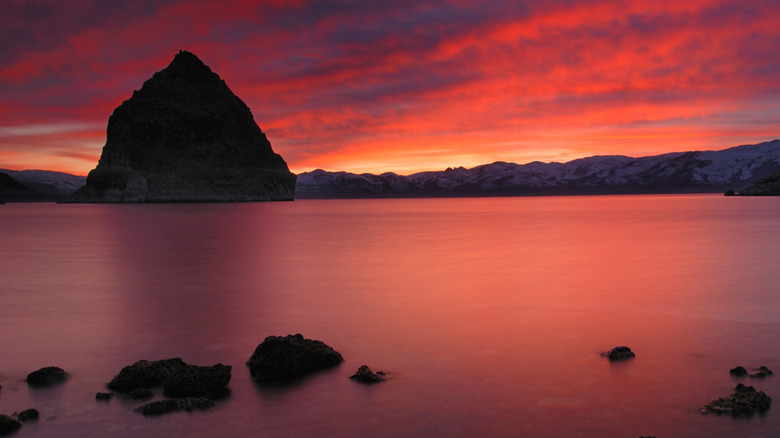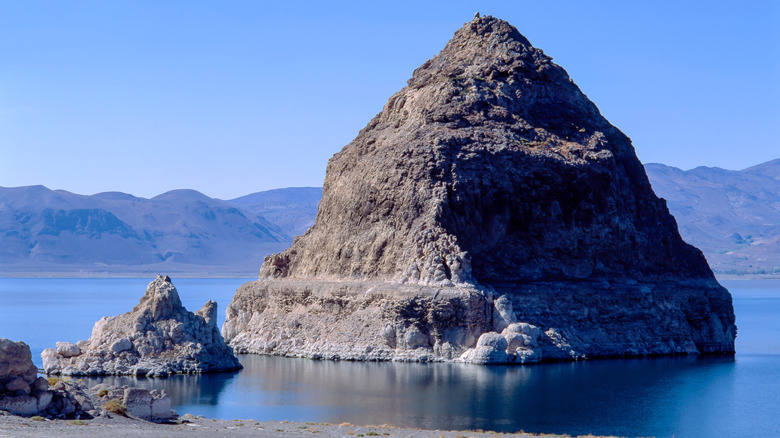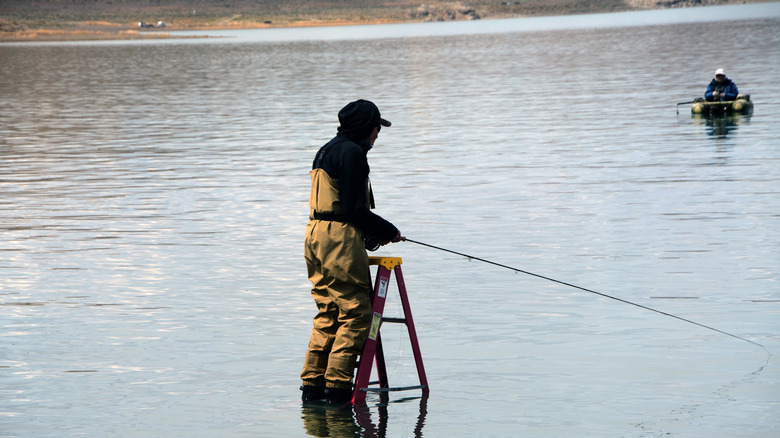You'll Need A Tribal Permit To Swim In This Ancient Nevada Salt Lake's Sacred Blue Waters
Nevada's largest natural lake is also one of the most mysterious. Just 48 miles northeast of Reno inside the Pyramid Lake Paiute Tribe Reservation, this fascinating geological wonder and hub of Paiute culture and knowledge is a worthy day trip from the biggest little city in Northern Nevada — particularly if you like fishing and swimming. Pyramid Lake is also home to the world's largest cutthroat trout. A massive catch for eager anglers, the largest Lahontian cutthroat ever caught weighed 41 pounds. Lake Tahoe might have crystal-clear water, but it definitely doesn't have that.
While people are welcome to come and enjoy the lake's natural beauty and abundance, some areas remain off-limits. One of the most sacred rock formations in the area, the Great Stone Mother, is closed to the public due to past episodes of vandalism. You can visit Pyramid Island however, which is also the lake's namesake rock formation. The lake and island were named by a 19th-century American explorer, but the indigenous name for the island is Wono, which means "cone-shaped basket."
Swimming in Pyramid Lake is a wonderful way to cool down on a hot summer day while learning more about the local legends and the long history of the Paiute tribe, who looks after this sacred saltwater lake. Here's everything you need to know about the lake's background and how to secure your permit for swimming and fishing.
Learn about the history and legends of Pyramid Lake
Today, Pyramid Lake is 30 miles long and 7 to 9 miles wide according to Britannica, but it used to be a lot bigger as a part of Lake Lohantan. More than 12,000 years ago this ancient inland sea covered a surface area of over 8,500 square miles and stretched across northwest Nevada from Walker Lake to the Black Rock Desert and Battle Mountain, an underrated town surrounded by mountains. As the lake dried up over the millennia, it left behind many striking tufa rock formations that would become important landmarks to the Paiute people who settled in the area, a history that is well-documented at the Pyramid Lake Paiute Tribe Museum and Visitors Center. The lake was also the site of the deadly 1860 war that marked a stand-off between Native American tribes and Euro-American settlers.
As you explore the shores of the lake, you will likely hear many Paiute stories and legends associated with it, but none is quite as unnerving as the haunting myth of the "water babies." According to a story published in local Colorado paper The Granby Drummer, campers staying overnight are often warned that if they hear the sound of a crying baby coming from the lake, they should not go investigate or else risk being pulled in. The myth reportedly stems from an ancient practice of abandoning weak infants who did not have a chance of survival.
How to get a permit for Pyramid Lake
Pyramid Lake is open for recreation, but as the land is owned by the Pyramid Lake Paiute Tribal Council, visitors will need to secure the proper permits before fishing, swimming, and camping. Permits can be purchased from the official website or at the ranger station in Sutcliffe. You can also get your permit for boating and jet skis here in one-day or three-day packs (with the jet-ski passes being the most expensive). You must purchase a day pass to visit the reservation, even if you don't plan on stopping by the beach. However, the day pass is based per vehicle, not per person. Camping is allowed on the beach and in all the open areas of the reservation, but there is also an RV park in Sutcliffe where you will find hook-up sites.
To fish the famous Lahontian cutthroat trout, you can get a daily fishing permit and charter a boat with a local company like Pyramid Charter or go fly fishing with a registered guide like Pyramid Fly Co. The trout season runs from October 1 to June 30, and while you don't need a fishing license if you have the proper permit, any boat you take on the water needs to be registered with its respective state. Be sure to check the Pyramid Lake website to see further regulations, including which areas are restricted to fishing.


